Art of the Third Reich
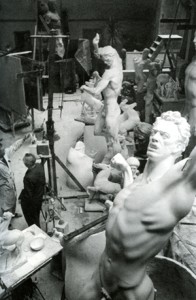
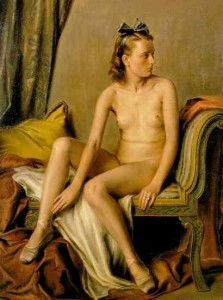
Weiblicher Akt, Adolf Ziegler, before 1942
The Art of the Third Reich, the officially approved art produced in Nazi Germany between 1933 and 1945, was characterized by a style ofRomantic realism based on classical models. While banning modern styles as degenerate, the Nazis promoted paintings and sculptures that were narrowly traditional in manner and that exalted the “blood and soil” values of racial purity, militarism, and obedience. Other popular themes for Nazi art were the Volk at work in the fields, a return to the simple virtues of Heimat (love of homeland), the manly virtues of the National Socialist struggle, and the lauding of the female activities of child bearing and raising (Kinder, Küche, Kirche).
Similarly, music was expected to be tonal and free of jazz influence; films and plays were censored.
Nazi art bears a close similarity to the Soviet propaganda art style of Socialist Realism, and the term heroic realism has sometimes been used to describe both artistic styles.
Among the well known artists endorsed by the Nazis were the sculptors Josef Thorak and Arno Breker, and painters Werner Peiner, Adolf Wissel and Conrad Hommel.
Historical background
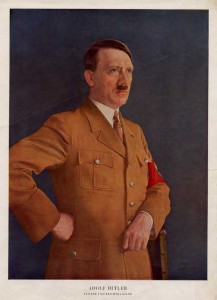
This widely distributed 1935 portrait is by Heinrich Knirr
The early twentieth century was characterized by startling changes in artistic styles. In the visual arts, such innovations as cubism, Dada and surrealism, following hot on the heels ofSymbolism, post-Impressionism and Fauvism, were not universally appreciated. The majority of people in Germany, as elsewhere, did not care for the new art which many resented as elitist, morally suspect and too often incomprehensible.
During recent years, Germany had become a major center of avant-garde art. It was the birthplace of Expressionism in painting and sculpture, the atonal musical compositions of Arnold Schoenberg, and the jazz-influenced work of Paul Hindemith and Kurt Weill. Robert Wiene’s The Cabinet of Dr. Caligari and Fritz Lang’s Metropolis brought expressionism to cinema.
The Nazis viewed the culture of the Weimar period with disgust. Their response stemmed partly from conservative aesthetics and partly from their determination to use culture aspropaganda. Upon becoming dictator in 1933, Hitler gave his personal artistic preference the force of law to a degree rarely known before. Only in Stalin’s Soviet Union, where Socialist Realism had become the mandatory style, had a state shown such concern with regulation of the arts. In the case of Germany, the model was to be classical Greek and Roman art, seen by Hitler as an art whose exterior form embodied an inner racial ideal.
The reason for this, as historian Henry Grosshans indicates, is that Hitler “saw Greek and Roman art as uncontaminated by Jewish influences. Modern art was [seen as] an act of aesthetic violence by the Jews against the German spirit. Such was true to Hitler even though only Liebermann, Meidner, Freundlich, and Marc Chagall, among those who made significant contributions to the German modernist movement, were Jewish. But Hitler … took upon himself the responsibility of deciding who, in matters of culture, thought and acted like a Jew.”
The supposedly “Jewish” nature of art that was indecipherable, distorted, or that represented “depraved” subject matter was explained through the concept of degeneracy, which held that distorted and corrupted art was a symptom of an inferior race. By propagating the theory of degeneracy, the Nazis combined their anti-Semitism with their drive to control the culture, thus consolidating public support for both campaigns.
Their efforts in this regard were unquestionably aided by a popular hostility to Modernism that predated their movement.
Degenerate art
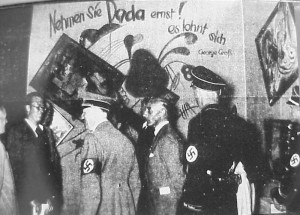
Adolf Hitler and Adolf Ziegler visit the Degenerate Art exhibition, 1937
The term Entartung (or “degeneracy”) had gained popularity in Germany by the late 19th century when the critic and author Max Nordaudevised the theory presented in his 1892 book, Entartung. Nordau drew upon the writings of the criminologist Cesare Lombroso, whoseThe Criminal Man, published in 1876, attempted to prove that there were “born criminals” whose atavistic personality traits could be detected by scientifically measuring abnormal physical characteristics. Nordau developed from this premise a critique of modern art, explained as the work of those so corrupted and enfeebled by modern life that they have lost the self-control needed to produce coherent works. Explaining the painterliness of Impressionism as the sign of a diseased visual cortex, he decried modern degeneracy while praising traditional German culture. Despite the fact that Nordau was Jewish (as was Lombroso), his theory of artistic degeneracy would be seized upon by German National Socialists during the Weimar Republic as a rallying point for their anti-Semitic and racist demand for Aryan purity in art.
Belief in a Germanic spirit—defined as mystical, rural, moral, bearing ancient wisdom, noble in the face of a tragic destiny—existed long before the rise of the Nazis; Richard Wagner celebrated such ideas in his work. Beginning before World War I the well-known German architect and painter Paul Schultze-Naumburg’s influential writings, which invoked racial theories in condemning modern art and architecture, supplied much of the basis for Adolf Hitler’s belief that classical Greece and the Middle Ages were the true sources of Aryan art. Hitler’s rise to power on January 31, 1933 was quickly followed by actions intended to cleanse the culture of degeneracy: book burnings were organized, artists and musicians were dismissed from teaching positions, artists were forbidden to utilize any colors not apparent in nature, to the “normal eye”, and curators who had shown a partiality to modern art were replaced by Party members.
Creation of the Reichskulturkammer
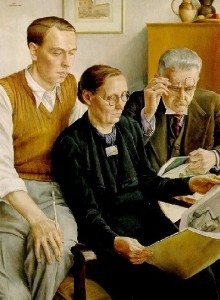
The Art Journal by Udo Wendel, 1940
In September 1933 the Reichskulturkammer (Reich Culture Chamber) was established, with Joseph Goebbels, Hitler’s Reichminister für Volksaufklärung und Propaganda (Reich Minister for Public Enlightenment and Propaganda) in charge. Subchambers within the Culture Chamber, representing the individual arts (music, film, literature, architecture, and the visual arts) were created; these were membership groups consisting of “racially pure” artists supportive of the Party, or willing to be compliant. Goebbels made it clear: “In future only those who are members of a chamber are allowed to be productive in our cultural life. Membership is open only to those who fulfill the entrance condition. In this way all unwanted and damaging elements have been excluded.” By 1935 the Reich Culture Chamber had 100,000 members.Nonetheless there was, during the period 1933-1934, some confusion within the Party on the question of Expressionism. Goebbels and some others believed that the forceful works of such artists as Emil Nolde, Ernst Barlach and Erich Heckel exemplified the Nordic spirit; as Goebbels explained, “We National Socialists are not unmodern; we are the carrier of a new modernity, not only in politics and in social matters, but also in art and intellectual matters.” However, a faction led by Rosenberg despised Expressionism, leading to a bitter ideological dispute which was settled only in September 1934, when Hitler declared that there would be no place for modernist experimentation in the Reich.
Modern artworks were purged from German museums. Over 5,000 works were initially seized, including 1,052 by Nolde, 759 by Heckel, 639 by Ernst Ludwig Kirchner and 508 by Max Beckmann, as well as smaller numbers of works by such artists as Alexander Archipenko, Marc Chagall, James Ensor, Henri Matisse, Pablo Picasso and Vincent van Gogh. These became the material for a defamatory exhibit,Entartete Kunst (“Degenerate Art”), featuring over 650 paintings, sculptures, prints, and books from the collections of thirty two German museums, that premiered in Munich on July 19, 1937 and remained on view until November 30 before travelling to eleven other cities in Germany and Austria. In this exhibition, the artworks were deliberately presented in a disorderly manner, and accompanied by mocking labels.
Coinciding with the Entartete Kunst exhibition, the Große Deutsche Kunstausstellung (Great German art exhibition) made its premiere amid much pageantry. This exhibition, held at the palatial Haus der deutschen Kunst (House of German Art), displayed the work of officially approved artists such as Arno Breker and Adolf Wissel. At the end of four months Entartete Kunst had attracted over two million visitors, nearly three and a half times the number that visited the nearby Grosse deutsche Kunstausstellung.
Genres in the Third Reich
Painting
In general, painting — once purged of “degenerate art” — was based on traditional genre painting. Titles were heavily significant, such as “Fruitful Land”, “Liberated Land”, “Standing Guard”, “Through Wind and Weather”, or “Blessing of Earth.”
Landscape painting featured mostly heavily in the Greater German Art exhibition. While drawing on German Romanticism traditions, it was to be firmly based on real landscape, Germans’ Lebensraum, without religious moods. Peasants were also popular images, reflecting a simple life in harmony with nature. This art showed no sign of the mechanization of farm work. The farmer labored by hand, with effort and struggle.
Nazi theory explicitly rejected “materialism”, and therefore, despite the realistic treatment of images, “realism” was a seldom used term. A painter was to create an ideal picture, for eternity. The images of men, and still more of women, were heavily stereotyped. This may have been the cause of their being very few anti-Semitic paintings; while such works asUm Haus and Hof, depicting a Jewish speculator dispossessing an elderly peasant couple exist, they are few, perhaps because the art was supposed to be on a higher plane. Explicitly political paintings were more common but still very rare. Heroic imagery, on the other hand, was common enough to be commented on by a critic: “The heroic element stands out. The worker, the farmer, the soldier are the themes ….. Heroic subjects dominate over sentimental ones”.
With the advent of war, war paintings became far more common. The images were heavily romanticized, depicting heroic sacrifice and victory. Still, landscapes still predominated, and among the painters exempted from war service, all were noted for landscapes or other pacific subjects.
Even Hitler and Goebbels found the new paintings disappointing, although Goebbels tried to put a good face on it with the observation that they had cleared the field, and that these desperate times drew many talents into political life rather than cultural.
Sculpture
Sculpture’s monumental possibilities gave it a better expression of Nazi racial theories. The Greater German Art Exhibit displayed, throughout Nazi years, a steady rise in the number of sculptures at the expense of paintings. The most common image was of the nude male, expressing the ideal of the Aryan race. Nude females were also common, though they tended to be less monumental.
Music
Germany’s urban centers in the 1920s and 30s were buzzing with jazz clubs, cabaret houses and avant garde music. In contrast, the National Socialist regime made concentrated efforts to shun modern music (which was considered degenerate and Jewish in nature) and instead embraced classical “German” music. Highly favored was music which alluded to a mythic, heroic German past such as Bach, Beethoven and Wagner. The music of Schoenberg (and atonal music along with it), Mahler, Mendelssohn and many others was banned because they were Jewish.
There has been controversy over the use of certain composers’ music by the Nazi regime, and whether that implicates the composer as implicitly Nazi. Composers such as Richard Strauss, who served as the first director of the Propaganda Ministry’s music division, and Carl Orff have been subject to extreme criticism and heated defense.
Graphic design
The poster became an important medium for propaganda during this period. Combining text and bold graphics, posters were extensively deployed both in Germany and in the areas occupied. Their typography reflected the Nazis’ official ideology. The use of Fraktur was common in Germany until 1941, when Martin Bormann denounced the typeface as “Judenlettern” and decreed that only Roman type should be used. Modern sans-serif typefaces were condemned as cultural Bolshevism, although Futura continued to be used owing to its practicality.
Imagery frequently drew on heroic realism. Nazi youth and the SS were depicted monumentally, with lighting posed to produce grandeur.
Popular art
Mass culture was less stringently regulated than high culture, possibly because the authorities feared the consequences of too heavy-handed interference in popular entertainment. Thus, until the outbreak of the war, most Hollywood films could be screened, including It Happened One Night, San Francisco, and Gone with the Wind. While performance of atonal music was banned, the prohibition of jazz was less strictly enforced. Benny Goodman and Django Reinhardt were popular, and leading English and American jazz bands continued to perform in major cities until the war; thereafter, dance bands officially played “swing” rather than the banned jazz.
Art theft
Later, as the occupiers of Europe, the Germans trawled the museums and private collections of Europe for suitably “Aryan” art to be acquired to fill a bombastic new gallery in Hitler’s home town of Linz. At first a pretense was made of exchanges of works (sometimes with Impressionist masterpieces, considered degenerate by the Nazis), but later acquisitions came through forced “donations” and eventually by simple looting.
Individual artists
In September 1944 the Ministry of Public Enlightenment and Propaganda prepared a list of 1,041 artists considered crucial to National Socialist culture, and therefore exempt from war service. This Gottbegnadeten list provides a well-documented index to the painters, sculptors, architects and filmmakers who were regarded by the Nazis as politically sympathetic, culturally valuable, and still residing in Germany at this late stage of the war.
Painting
- Thomas Baumgartner (1892-1962)
- Fritz Erler (1868-1940)
- Sepp Hilz (1906-1967)
- Walther Hoeck (1885-1956)
- Conrad Hommel (1883-1971)
- Trude Hoppe-Arendt
- Julius Paul Junghanns (1876-1953)
- Hubert Lanzinger (1880-1950), painter of “Adolf Hitler as Standard Bearer”
- Georg Lebrecht
- Ernst Liebermann (1869-1960)
- Oskar Martin-Amorbach (1897-1987)
- Paul Mathias Padua (1903-1981)
- Gisbert Palmie (1897-1984)
- Werner Peiner (1897-1984)
- Ivo Saliger (1894-1987)
- Leopold Schmutzler (1864-1940)
- Georg Sluyterman von Langeweyde (1903-1978)
- Edmund Steppes (1873-1968)
- Karl Truppe (1887-1952)
- Udo Wendel
- Wolfgang Willrich (1897-1948)
- Adolf Wissel (1894-1973)
- Adolf Ziegler (1892-1959)
Sculpture
- Karl Albiker
- Arno Breker
- Fritz Klimsch
- Fritz Koelle
- Georg Kolbe
- Ferdinand Liebermann
- Willy Meller
- Richard Scheibe
- Adolf Wamper
- Josef Thorak
- Franz Nagy
- Karl Diebitsch
- Prof. Theodor Karner
Source: en.wikipedia.org


This Post Has 0 Comments